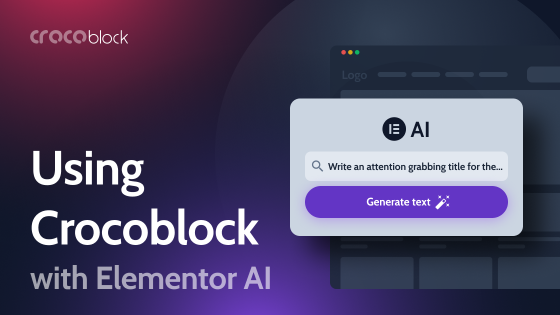I cannot believe Crocoblock is almost five years old! 🎂
Celebrating the occasion, we couldn’t help but feel nostalgic and remember all the good times and pivotal moments. Great things start small, as they say. It’s been a pleasure to stroll down memory lane, relive those experiences, and witness a small yet ambitious startup growing into a 70-people project. Impressive, is it not?
Now, it’s right about time to spread the joy. 🙌🏼
Let me take you five years back and show you what challenges Crocoblock had to face, what it brought to the industry, and who made Crocoblock what it is today.
Table of Contents
- History: How It All Started
- About Crocoblock: Faces Behind the Brand
- Main Challenges
- Crocoblock Innovations
- To Be Continued
History: How It All Started
The Crocoblock story traces back to 2014. It looked a lot different and had a different logo. 🐊 At the time, we were a small product team who created WordPress themes. Each theme contained a physically separate code and demo content that made the theme attractive to customers. Today, Crocoblock no longer has such a concept, but formally, our dynamic and design templates are the closest to it.
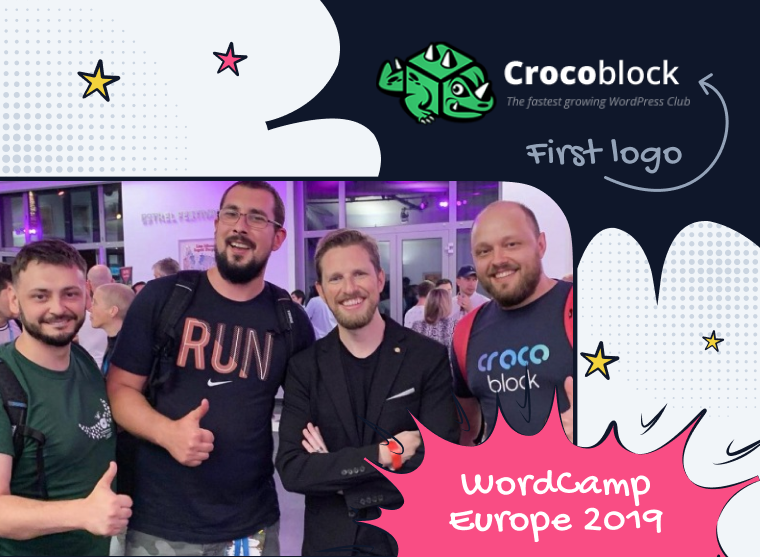
The main problem was finding a way to create demo content so the user could edit it conveniently. At the time, there weren’t many visual builders to choose from, and those existing on the market were problematic or unavailable due to license restrictions.
Looking for a solution, we wandered from one editor to another until, almost by accident, we decided to try Elementor. We turned a blind eye to a critical problem it had back then and took our chances.
Key milestones
To make the transition to Elementor smooth, we had to solve several main tasks:
- Organize a pipeline production for coders to create new themes as quickly as possible.
- Provide design opportunities and make sure designers can draw anything they wish without having to worry about restrictions.
- Provide certain coding freedom and create a centralized library storing all elements used in the themes.
- Make the design process visual, giving the ability to change elements like colors, typography, spacing, etc., from the editor.
2017-2018
It soon became clear that the Elementor core was not enough to cover all these tasks, so we needed to develop additional solutions. These solutions should be implemented as separate plugins (according to the WordPress concept, plugins give functionality, and themes contain design).
Furthermore, we combed through MANY different designs and realized the majority of the elements they contain are standardized and can be reduced to a limited number of Elementor widgets. This is how JetElements appeared, our first plugin with a set of basic widgets for every website type.
Next, we witnessed the growing popularity of magazine-like WordPress themes. After having researched the competitors, we saw that such themes also contained a limited set of elements. So, we created JetBlog.
Somewhere along the road, the product concept called for change. We’ve had plugins now, not just themes, and these plugins could interest the end user. So we grabbed JetElements and went to sell it at CodeCanyon.
For some time, the plugin had been among the most popular add-ons for Elementor since we kept updating it and processed numerous requests from coders who created new themes using JetElements.
It was smooth sailing – we got a task and developed a plugin to tackle it; the plugin fueled the production of themes while being sold as a separate product. Soon after, we released JetMenu, JetTabs, JetReviews, JetWooBuilder, and JetBlocks.
Over time, the plugin range extended, and their value increased. It was the perfect time to revive Crocoblock. Since 2018, the project has stepped into its new era, all thanks to its founding fathers – Andriy Andreyev (CEO) and Andriy Shevchenko (CTO).
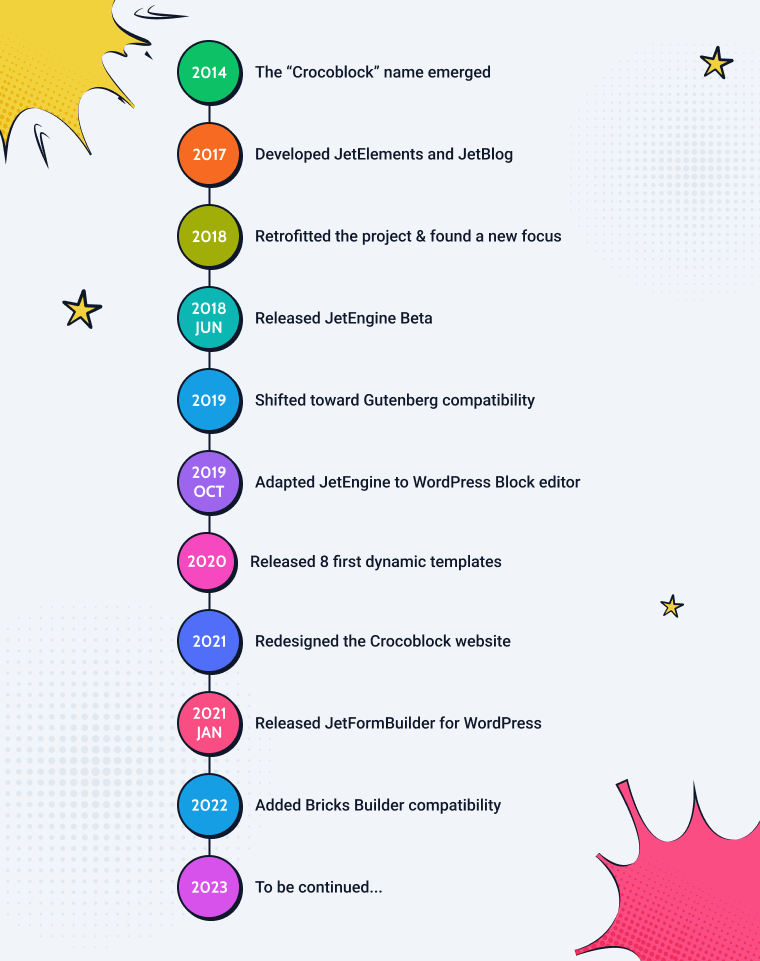
2018-2019
At first, Crocoblock was far from dynamic solutions; it mainly focused on design. We were devoted to theme-making without focusing much on functionality. At a certain point, we faced that it wasn’t enough for our users. We wanted them to be able to create fully functional websites using our plugins, but there wasn’t a ready-made solution. Therefore, we released JetEngine, a plugin for creating dynamic content entities such as custom post types, meta fields, and taxonomies without having to do the actual coding.
The idea is not revolutionary; some plugin providers have been around longer than Crocoblock. But what we managed to do is to connect complex dynamics with design in Elementor’s UI. As a result, we lowered the threshold for our users to enter the world of dynamic websites and made it possible to move from blogs, small business sites, and WordPress landing pages to more complex projects.
After JetEngine, we developed JetSmartFilters, more plugins for eCommerce, JetSearch, and JetPopup. The plugin focus has shifted from design to functionality.
2019-present day
Then the Lego-like website building emerged, and this is something we still haven’t implemented to the fullest and what someday is likely to become our most significant achievement.
According to this concept, a site of any complexity can be divided into structural parts – Lego cubes, modules, or components (you can call them whatever you like). Each component is not so difficult to implement, but when used together, they will create a unique website. With that in mind, we released JetBooking, JetAppointment, JetFormBuilder plugins, and most JetEngine modules.
Another pivotal moment to bring up is a detour toward better Gutenberg editor compatibility. Most (if not all) JetPlugins have been intended initially for Elementor use, so they showed the best possible compatibility there. In October 2019, we released JetEngine 2.1.0 and started adapting other JetPlugins to the WordPress native editor.
As explained by Andriy Shevchenko:
“There were several reasons for doing so. First, we wanted to give users the ability to choose which builder they prefer to use. The code responsible for rendering elements on the front end is 90% independent of the builder. For that matter, we wanted to ensure higher rendering speed, especially for listings. Lastly, Gutenberg is a WordPress native editor, and we wanted to abide by its principles and make our plugins self-sufficient.”
And what about the Crocoblock website? It’s been patient enough to wait for a complete makeover. 😆 Here is what the Crocoblock website looked like at first:
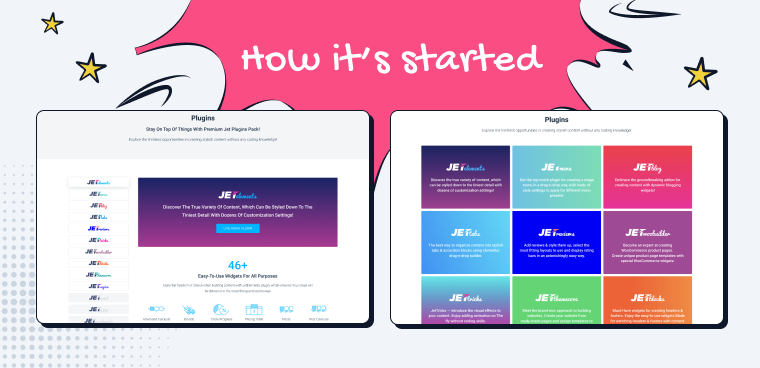
And that’s the current design you all know and adore:

Until now, we have kept up the good work and tried hard to release more new features, updates, and compatibilities. Our latest development (2022) involved Bricks Builder, JetEngine, and JetSmartFilters. We plan to expand the Bricks integration and add compatibility for other dynamic plugins, like JetBooking, JetAppointment, and JetFormBuilder.
About Crocoblock: Faces Behind the Brand
Enough about the brand; I’m sure you are eager to learn more about those who made it. 🤗
The Crocoblock team has grown from 5 to 70 people. I like to think it’s not a team but a community where everyone is passionate about what they do and knows how to do a good job. We are like-minded individuals, and each tends to bring something original to the table.
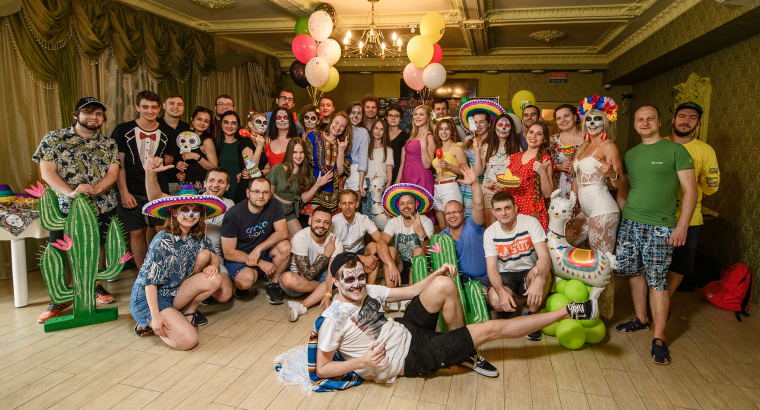
At present, the team comprises:
- 2 founding fathers
- 11 developers and coders
- 4 QA specialists
- 20 support agents
- 1 COO/product owner
- 2 project managers
- 1 SMM specialist
- 1 SEO specialist
- 1 affiliate/outreach manager
- 3 technical writers
- 4 copywriters
- 4 designers
- 2 video creators
Today, Crocoblock is a separate project owned and operated by a holding company, Jetimpex Inc. The project has been steadily growing its following while perfecting its product range. So far, JetPlugins have collectively reached 80K+ installs and rising.
Main Challenges
“Every challenge you face today makes you stronger tomorrow.” – Roy T. Bennett.
Honestly, I couldn’t agree more. Business is about perpetual growth, about being ready to go all the way and face challenges, whatever they may be.
- The first challenge was to decide which builder to choose for our plugin development. After some wandering, we decided to give Elementor a try. The whole thing worked like a charm. JetPlugins became known and spoken about.
- The second challenge was to start a separate project considering we already had other tasks in the company. It was not easy to bring ourselves to do it, but we found the greatest motivation in our community, which had constantly been asking us to launch a project.
- Another problem we had to handle was the WordPress development plans. Since the WordPress team announced FSE (full site editing) development, the process has been relatively slow, leaving all plugin developers wondering what would be better to develop next. We cannot anticipate what will come in the next WordPress releases, too, so much is left for juggling.
- Then COVID-19 had stricken, and we had to organize efficient work. Because our team members worked from different cities – Kyiv, Lviv, and Mykolaiv – it was quite a challenge.
“We {the Mykolaiv team} are used to working from the office, and we wanted to keep coming there. I guess the biggest challenge was to organize safe transfers from people’s homes to the office and the other way around; plus, the need to follow the sanitary standards.” (Anna Hurko)
COVID made us realize how important it is to stay connected, try and socialize, especially during a lockdown. Little did we know about the worst challenge awaiting us.
- 2022 split our lives into “before” and “after”; a full-scale invasion launched by the neighboring country made us go into survival mode. We got scattered all over Ukraine; some even went abroad. It wasn’t safe to keep working from the office anymore, so we got to do what needed to be done – learn how to work remotely.
But did it stop us from delivering? Never. We kept working from shelters, coding from basements, processing support tickets in the dark, and doing the best we could.
We are hoping the war will be the last negative experience to endure. At least we know how resilient we are and have what it takes to keep up the good work no matter what. 😅
Crocoblock Innovations
The entire Crocoblock philosophy revolves around dynamic content and making the websites dynamic. Our #1 best-seller, JetEngine, is configured to give web creators more freedom and development opportunities.
Dynamic content and its power
There are three stages to handling dynamic content:
- creating a data structure and data input (CPT, taxonomy terms, meta fields, CCT, relations);
- fetching data from the database;
- data output on the front end.
“Speaking about their attractiveness and attention focus for the client, they go in reverse order. The most appealing opportunity is actually the third stage – data output.” (Andriy Shevchenko)
The JetEngine plugin offers multiple options for showcasing data dynamically. For instance, these three powerful widgets/blocks – Dynamic Field, Dynamic Image, and Dynamic Link – give many customization options for the content you wish to output. Namely, change the format, customize the output using callbacks, use dynamic elements in the URL and labels for links, make images clickable, and add dynamic URLs. Moreover, these widgets/blocks are versatile, meaning you can use them when building a listing and a single page.
Now, let’s talk about getting data from the database and our tool – Query Builder. What makes it innovative is the ability to receive many data types, which competitors rarely offer. In addition to commonplace posts, terms, and users, we have the following:
- a separate Query Type for getting WooCommerce data;
- the ability to get data directly from any tables in the database;
- the ability to receive data from third-party resources via REST API;
- fetching data from meta fields like a repeater.
NOTE
In addition, the data returned by the Query Builder are unified. Every query type returns the result in the same format, which can be further used in the Listing.
Some more honorable mentions
Among the remaining dynamic features, it is worth bringing up the following:
- It is possible to create meta fields for posts, terms, and users and add their values to the REST API responses for posts, terms, and users. JetEngine creates standard endpoints from the core, which one can only do through coding.
- The Global Options pages feature allows you to create new options and provides a UI for editing them. Moreover, you can use global options as a UI for editing the core and third-party plugins’ options.
- Relationship Builder makes it possible to connect two different content types – CPT + CPT, CPT + Users, CPT + Terms, Terms + Users, etc.
- CCTs (custom content types) allow you to create custom database tables and store any data there. Data from these tables will be available in the Query Builder and can be displayed using listings.
Theme Builder and visual theme parts creation
Theme Builder from the JetThemeCore plugin makes the whole process of theme template creation visual. The builder shows which header, footer, and body templates are applied to which pages. In addition, you can create new templates using a one-stop dashboard, edit the existing templates, and configure their visibility.
“These functions should be theoretically performed by the Site Editor, yet since it currently doesn’t, we give the user a tool for building such a structure while making it all visual.” (Andriy Shevchenko)
Other features you might find handy
- Smart filters – you can filter listings anyhow you want. Different apply types are available; AJAX filtering without reloading the page, a regular page reload option, and a mixed variant.
- AJAX search – it’s a way to build a convenient and smoothly running search tool.
- Pop-up builder – you can create static pop-ups for marketing purposes and dynamic pop-ups to output forms, quick-view images, and other dynamic content.
- Mega menu – using JetMenu, one can create content-rich mega menus for the desktop and simple hamburger panels for mobile devices.
- Form builder – build different form types in the native WordPress block editor.
To Be Continued
Wow, what a journey! For a young project, Crocoblock has indeed faced many challenges, which helped it grow and made it exceptional.
What makes us all proud today:
- The fact our project is recognized among the WordPress community members.
- Crocoblock products are truly helping people develop WordPress websites.
- Our team has grown from five to a whopping 70 people.
- Every team member is a professional.
- We always strive to get creative and find room for improvement.
- We are lucky to have gathered the finest Crocoblock Community out there.
The best is yet to come, right? Thank you for being there all the way. 🤗
P.S. Don’t miss the Crocoblock B-day announcements; there will be SALES! 🤑

